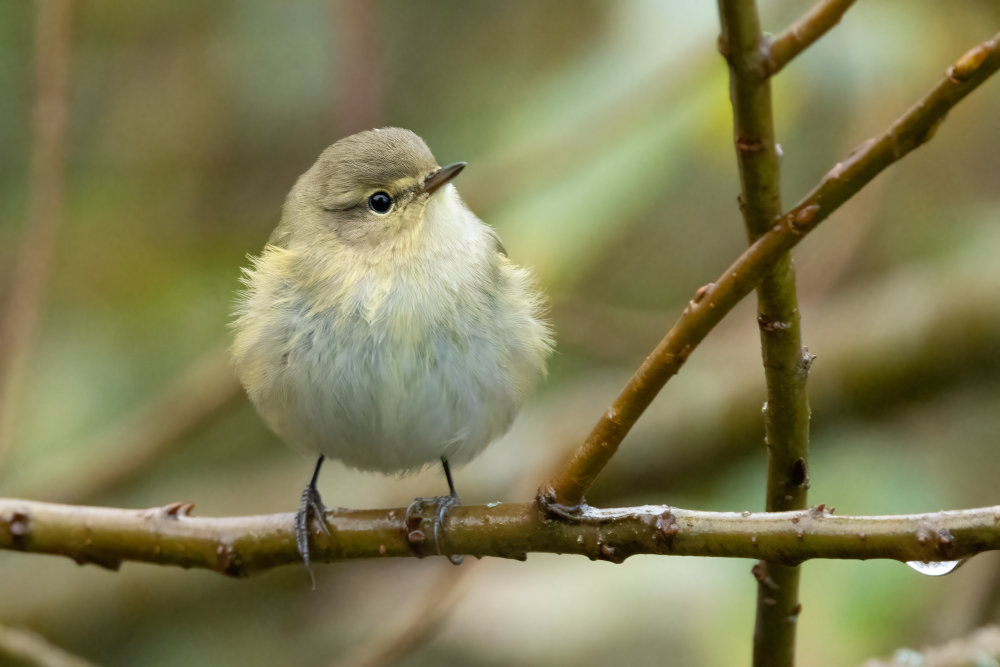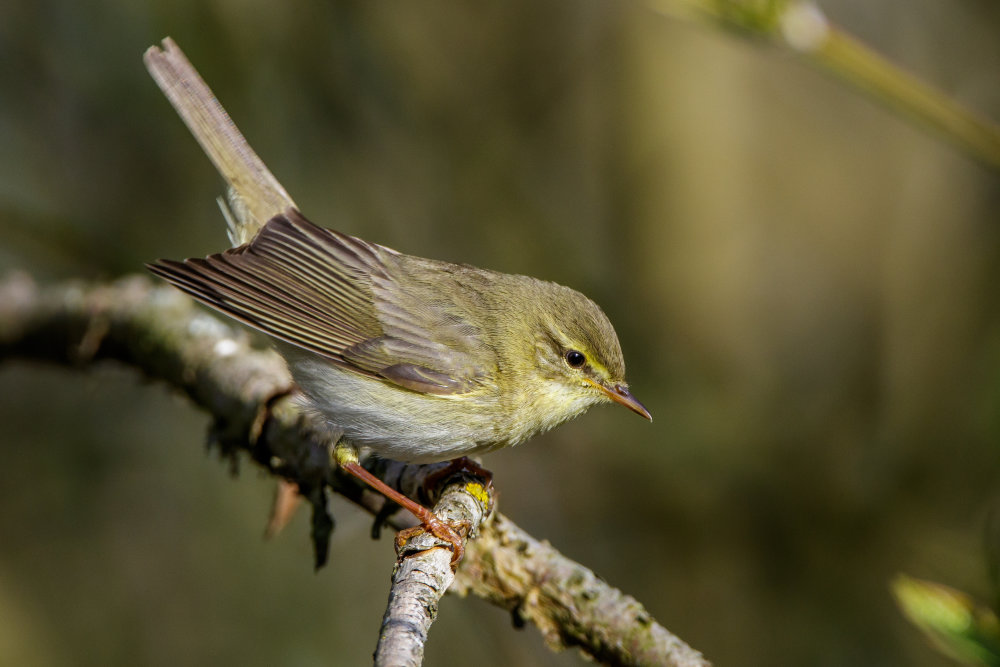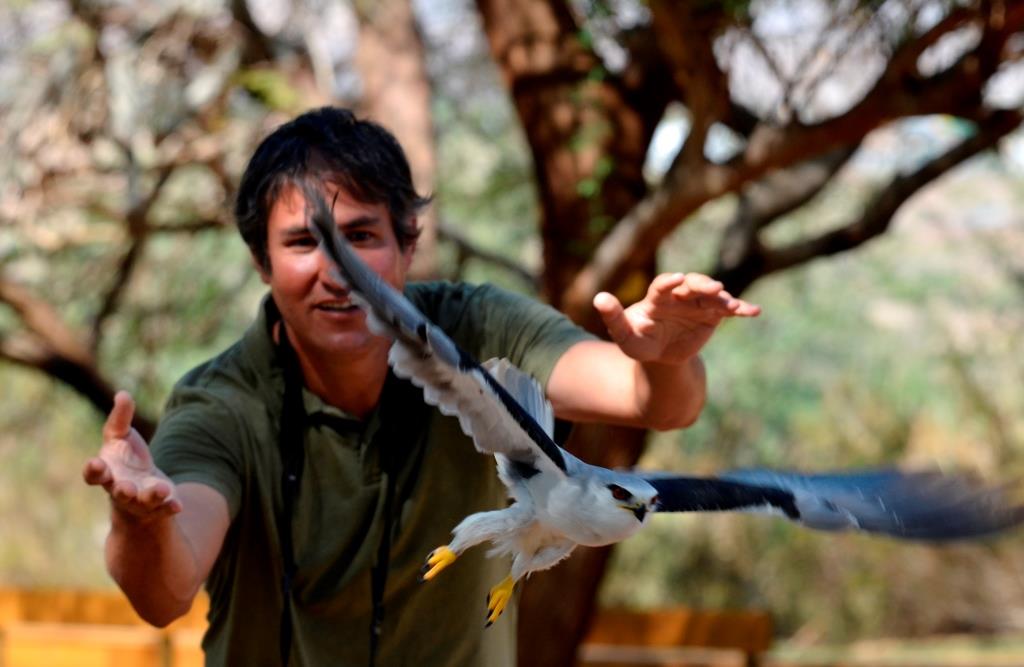With spring well & truly here, there are one family of birds that arrive here in the Europe and the UK that fill our scrubland, hedgerows but also the reedbeds with their beautiful songs which is of course the Warblers. But when they do show themselves, it can be difficult but also easy to misidentify these birds. The aim of this article will be to help distinguish between the commoner species.
For each species there will be a photo, link to Xeno Canto which is a website with 1000s of bird recordings where you can hear the song & calls for each species. At the end there will be a table with what habitats you expect to find each species.
Chiffchaff
In Europe and the UK, the first warbler you’ll likely hear from March onwards is the Chiffchaff. Where the names comes from the song of this bird, giving a lovely “chiff chaff chiff chaff” call. One of the more recognisable songs but when they aren’t singing then correctly identifying this species can be hard at times. In comparison to the Willow Warbler which is where the confusion can lie, the Chiffchaff has an overall duller appearance but the leg colour is always key. The Chiffchaff will have dark black legs. It is becoming a more regular sighting that Chiffchaffs are over-wintering here in the UK as well
Xeno Canto Chiffchaff – https://xeno-canto.org/species/Phylloscopus-collybita

(© Lothar Lenz- stock.adobe.com)
Willow Warbler
The Willow Warbler, as touched on above is similar to the Chiffchaff but the key differences are an overall brighter green/yellow appearance to that of the Chiffchaff but also yellow/orange legs, do note that the light you’re very these birds can vary which will make getting this identification feature correct every time can be hard. The song of a Willow Warbler can often be described as a soft, repeated whilst interjected with sweet notes.
Xeno Canto Willow Warbler – https://xeno-canto.org/species/Phylloscopus-trochilus

(© Rolf Mueller– stock.adobe.com)
Wood Warbler
To finish this trio of similar Warblers it leaves us with the Wood Warbler. In the UK this is the rarest of the three species, being found in mature oak woodlands in upland areas of England, Scotland & Wales. Thankfully this is also the easiest to separate on sight & by song, with a clean white belly along with the vibrant green & yellow plumage this species will often be in the canopy of a woodland where the song will attract you to the location of this species. Very distinctive trill which parachutes as the song continues.
Xeno Canto Wood Warbler – https://xeno-canto.org/species/Phylloscopus-sibilatrix

(© AGAMI photo agency– stock.adobe.com)
Eurasian Blackcap
In Europe and the UK, the Eurasian Blackcap is up there with the Chiffchaff in terms of commonest Warblers. But thankfully the Blackcap is easily recognisable, as the name suggests the males have an obvious black cap compared to the females which have a rusty, brown cap. As for the rest of their plumage, a noticeable grey face & neck with an overall olive appearance on the wings & belly. But it is the song that can easily be misidentified with a Garden Warbler. The song starts of with a short “chatter” followed quickly by a series of flute-like notes. But be aware they have the tendency to occasionally mimic other species with raspy notes.
Xeno Canto Eurasian Blackcap – https://xeno-canto.org/species/Sylvia-atricapilla

(© stock.adobe.com)
Garden Warbler
The Garden Warbler on appearance looks relatively drab but on closer inspection the subtle colours of grey, olive & green can really stand out. With no obvious black or red cap on this warbler it is easy to separate from the Blackcap but the song is where the identification can be difficult, especially as Garden Warblers can be very skulky by keeping deep within vegetation when singing. The song includes very rapid, deep notes but does lack any melody, there isn’t any flute-like notes that a Blackcap does has.
Xeno Canto Garden Warbler – https://xeno-canto.org/species/Sylvia-borin

(© AGAMI photo agency – stock.adobe.com)
Common Whitethroat
The Common Whitethroat is a charismatic species which we normally associate with farmland areas & hedgerows, the males are most obvious when they sing from their favourite perches. Rusty tones on the wings & back is contrasted against a clean white throat along with a grey head. The song is very recognisable with it’s short, hoarse call which can seem jerky in rhythm. They also sing this song whilst in flight as well as being perched on a bush.
Xeno Canto Common Whitethroat – https://xeno-canto.org/species/Curruca-communis

(© Mike Lane – stock.adobe.com)
Lesser Whitethroat
The Lesser Whitethroat in appearance looks very similar to a Common Whitethroat, but the Lesser Whitethroat is slightly smaller and appears to have more of a mask with a dark grey head, clean white throat & brown wings. This is a shyer species, rarely sitting out in the open for long & will usually sing from deep inside vegetation. The song appears with a sudden burst of rattles followed by a few scratchy notes which suddenly ends.
Xeno Canto Lesser Whitethroat – https://xeno-canto.org/species/Curruca-curruca

(© stock.adobe.com)
Eurasian Reed Warbler
As is suggested in the name, the Eurasian Reed Warbler is most commonly found in areas of reeds. This bird has an overall olive/brown appearance with very little markings, due to this apparent drab appearance there aren’t too many other species that a Reed Warbler can be confused from as most warblers won’t sing in a reedbed. As for the song, this can appear to be quite a slow-paced series of notes that repeats itself every few seconds, but never speeds up in pace.
Xeno Canto Eurasian Reed Warbler – https://xeno-canto.org/species/Acrocephalus-scirpaceus

(© stock.adobe.com)
Sedge Warbler
The Sedge Warbler inhabits a similar area to the Reed Warbler but can also be found in more scrubby areas. Main differences to a Reed Warbler are the obvious white eyestripe, brown head, mottled pattern on the wings along with the cream-coloured breast. With the song, the Sedge Warbler can seem to be very excited giving a series of rapid whistles which is often pieced together with mimicry of other bird song.
Xeno Canto Sedge Warbler – https://xeno-canto.org/species/Acrocephalus-schoenobaenus

(© Benny Trapp – stock.adobe.com)
Common Grasshopper Warbler
The Common Grasshopper Warbler is a true iconic in the Warbler family, whilst it’s appearance my seem drab with it’s streaky, brown & cryptic plumage that allows it to hide in vegetation. It’s the song that makes this species stand out and the reason for its name… they sound like a Grasshopper that has a megaphone to it’s mouth. These loud reels make it unmistakable, if your lucky enough they do occasionally “reel” out in the open, allowing for some great views of what is usually a shy species.
Xeno Canto Common Grasshopper Warbler – https://xeno-canto.org/species/Locustella-naevia

(© AGAMI Photo Agency – stock.adobe.com)
Cetti’s Warbler
Finally, the Cetti’s Warbler. Unlike the other Warblers in this article, the Cetti’s Warbler is resident here in the UK all year round. This is known for being extremely hard to see, with its rusty toned plumage, grey eyestripe & pale belly. This shy Warbler makes itself known when it sings, in an area of scrub near a water body you’ll suddenly hear an explosion of metallic notes in short succession.
Xeno Canto Cetti’s Warbler – https://xeno-canto.org/species/Cettia-cetti

(© stock.adobe.com)
Below is a table which shows in which habitat where you’re likely to find the Warblers that are included in this article.
| Habitat | |||||
| Scrubland | Hedgerows | Woodland | Reedbed | ||
| Species of Warbler | Chiffchaff | x | x | x | |
| Willow Warbler | x | x | x | ||
| Wood Warbler | x | ||||
| Eurasian Blackcap | x | x | x | ||
| Garden Warbler | x | x | |||
| Whitethroat | x | x | |||
| Lesser Whitethroat | x | x | |||
| Eurasian Reed Warbler | x | ||||
| Sedge Warbler | x | x | x | ||
| Common Grasshopper Warbler | x | x | x | ||
| Cetti’s Warbler | x | x | |||

